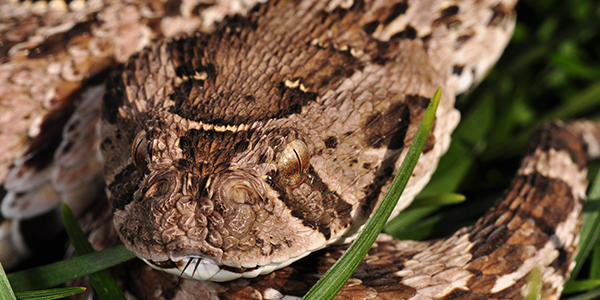Puff adders play an important role in conservation and as a rodent control solution
- Wits University
One of Africa's most widespread snakes could be agricultural hero in disguise.
New research from the University of the Witwatersrand in Johannesburg, South Africa, has revealed that puff adders (Bitis arietans) can be highly efficient at controlling rodent populations that threaten agricultural production on the continent.

Puff adders can increase their food consumption by more than 12 times above their maintenance levels when rodent populations surge — far outperforming traditional mammalian predators and offering a natural solution to devastating rodent pest problems.
"Puff adders are essentially nature's perfect rodent control system," says Professor Graham Alexander, who conducted the study. "Their ability to dramatically increase consumption during rodent outbreaks makes them invaluable allies for farmers facing potential crop devastation."
Published in Scientific Reports, the study shows that individual adders can consume up to 10 rodents in a single feeding session. They are ready to feed again just a week later, providing continuous pest management with zero cost to farmers. Rodent outbreaks during high rainfall years cause millions in crop damage annually, but maintaining healthy puff adder populations could significantly reduce these losses without costly chemical interventions.
Offering a compelling case for snake conservation, the research identifies several key advantages of puff adders as natural pest controllers:
- Their ability to increase consumption above maintenance levels dramatically outperforms mammalian predators such as weasels and lynx
- They can survive up to two years without food after periods of abundant feeding, remaining in the ecosystem as "on-call" rodent controllers
- They adapt their hunting to target rodents specifically when populations begin increasing
- They can respond rapidly to prevent rodent numbers from reaching plague proportions
"What's particularly valuable about puff adders is their natural abundance in many African habitats," says Alexander. "While an individual Puff Adder consumes much less than a fox or mongoose, their higher population abundance creates a formidable collective impact on rodent numbers."
In conducting this research, Alexander used a new measure called "factorial scope of ingestion," which measures how much a predator can increase its food intake above normal maintenance levels, as well as the impact that a large population of snakes might have on prey animals. By increasing their prey intake by 12 times their normal food needs during rodent blooms, a large population of snakes can have a considerable impact on keeping possible pest outbursts under control. This study challenges the traditional view of snakes as agricultural pests and reframes them as beneficial partners for sustainable farming.
"These findings demonstrate that puff adder population management should be an essential component of integrated pest management strategies," says Alexander. "By protecting these natural controllers, we can harness their remarkable abilities to support both ecosystem health and agricultural productivity across Africa. This also highlights the need to have snakes included in conservation management plans."

